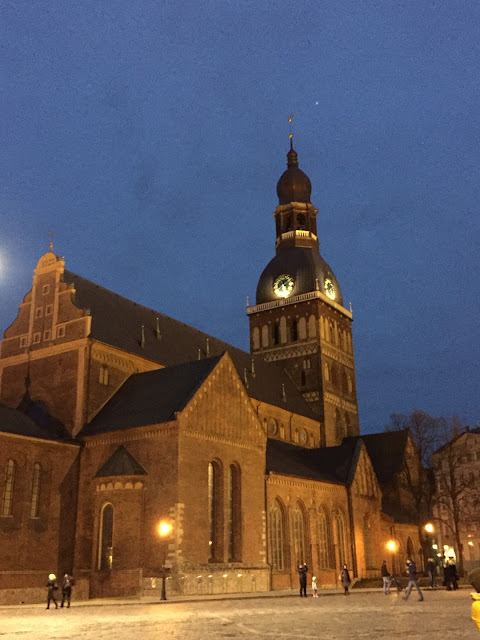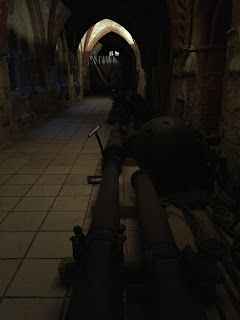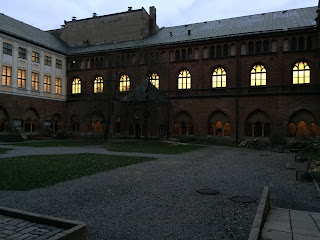199. Regional Travel #4.6 - Riga Dom
The main cathedral in Latvia's capital, known as Riga Dom, is one of three Lutheran cathedrals in Latvia. It is located in the central square of the city, and is one of Riga's best-known landmarks. The site for the cathedral, cloister, and Bishop's castle was consecrated on July 25, 1211. The Dom church was constructed later in the thirteenth century, with expansions completed in the fourteenth, fifteenth, and eighteenth centuries. New entrances and vestibules were added in the late nineteenth and early twentieth centuries. The original Roman Catholic altars, paintings, and sculptures were all lost or destroyed during the Protestant Reformation in the 16th century, so the present Evangelical Lutheran interior and decorations date to the seventeenth century. It serves as the seat of the Lutheran Archbishop of Riga.
One of the most interesting features found inside the Cathedral is the pipe organ. The big organ in the Dom is the second largest organ in Latvia, with 6,678 pipes. The present instrument is the third pipe organ to be located here. The first was destroyed in a fire in 1547 and the second was rendered inoperable by a lightning strike in 1707. The third organ was built in 1883-1884 and still performs today. The present-day facade of the organ is not a functional part of the instrument. Rather, it is a legacy of earlier versions of the organ dating to Mannerist, Baroque, and Rococo periods. Parts of the facade are more than 400 years old, and it is among the oldest preserved organ facades in Europe. The design and layout of the organ and its facade evolved during occasional projects in the eighteenth and nineteenth centuries. Several rounds of renovation projects continued throughout the twentieth century; the current restoration of the organ facade began in the year 2000.
The tombstone of St. Meinhard (on the wall at left). St. Meinhard was the first known Christian missionary to visit Livonia in approximately 1180. Upon his death in 1196, he was buried in Ikskile and later moved to the Riga Dom at the end of the fourteenth century. He was canonized in 1995, in part due to his presence during a famine when empty grain bins were miraculously filled with flour. I'm surprised it took 800 years for the church to officially certify him! --
The baptismal basin of St. Meinhard. This dates from the end of the twelfth century and was moved from its original home in Ikskile to Riga in 1893:
The cloister outside the church connects the cathedral with the Dom Chapter (originally used as the home of the highest clerical council, which was established in 1215). Today, the building houses the Museum of the History of Riga and Navigation. The cloister contains various art, artifacts, tombstones, statuary, and cannons:
This urn contains the heart of Carl Gustav Jochmann, a distinguished author, philosopher, and critic who was born in Estonia and later spent time in Latvia, France, Switzerland, and Germany. He lived in Riga from 1810 to 1819:
An artisan hard at work on the restoration of the big organ and its facade inside Riga Dom:
One of the most interesting features found inside the Cathedral is the pipe organ. The big organ in the Dom is the second largest organ in Latvia, with 6,678 pipes. The present instrument is the third pipe organ to be located here. The first was destroyed in a fire in 1547 and the second was rendered inoperable by a lightning strike in 1707. The third organ was built in 1883-1884 and still performs today. The present-day facade of the organ is not a functional part of the instrument. Rather, it is a legacy of earlier versions of the organ dating to Mannerist, Baroque, and Rococo periods. Parts of the facade are more than 400 years old, and it is among the oldest preserved organ facades in Europe. The design and layout of the organ and its facade evolved during occasional projects in the eighteenth and nineteenth centuries. Several rounds of renovation projects continued throughout the twentieth century; the current restoration of the organ facade began in the year 2000.
The tombstone of St. Meinhard (on the wall at left). St. Meinhard was the first known Christian missionary to visit Livonia in approximately 1180. Upon his death in 1196, he was buried in Ikskile and later moved to the Riga Dom at the end of the fourteenth century. He was canonized in 1995, in part due to his presence during a famine when empty grain bins were miraculously filled with flour. I'm surprised it took 800 years for the church to officially certify him! --
The baptismal basin of St. Meinhard. This dates from the end of the twelfth century and was moved from its original home in Ikskile to Riga in 1893:
The cloister outside the church connects the cathedral with the Dom Chapter (originally used as the home of the highest clerical council, which was established in 1215). Today, the building houses the Museum of the History of Riga and Navigation. The cloister contains various art, artifacts, tombstones, statuary, and cannons:
This urn contains the heart of Carl Gustav Jochmann, a distinguished author, philosopher, and critic who was born in Estonia and later spent time in Latvia, France, Switzerland, and Germany. He lived in Riga from 1810 to 1819:
An artisan hard at work on the restoration of the big organ and its facade inside Riga Dom:

























Comments
Post a Comment